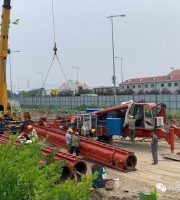The diameter of the drill bit is φ 3.15m~ φ 3.22m, drill the hole to the elevation of -49m, the design elevation of the bottom opening of the steel casing is -50m, and leave 1m to be vibrated in place with ape vibrating hammer.
The drilling methods of bored piles mainly include: rotary drilling rig, positive and negative circulation drilling rig, casing drilling rig, impact drilling rig, etc.
The power drill bit can drill at low speed by forward rotation, and dump soil at high speed by reverse rotation.
It has good protection against hole collapse and can be constructed near existing buildings.
This method can realize dry construction without mud mucking and has good environmental protection.
Install first φ 3.4m temporary casing, the depth of the temporary casing into the soil is about 10m, and then the drilling rig is installed.
The casing is manufactured in the steel structure factory, formed by the plate rolling machine, and welded on the rotating jig frame by the automatic electric welding machine.
According to the mud circulation method, it can be divided into positive circulation and reverse circulation.
If the pile hole is excavated manually, it is called digging pile; if the hole is excavated mechanically, it is called drilling pile.
The construction of bored cast-in-place pile is to make a pile hole in the soil manually or mechanically, then put the reinforcement cage of the pile body into the pile hole, pour concrete into the hole to form a pile, and finally pour tie beam or bearing platform at the top of the pile.
Pile bottom grouting: in order to make the grouting pipeline at the bottom of the reinforcement cage as close to the hole bottom as possible without damage, a bottom touch indicator switch is installed at the bottom of the reinforcement cage.
Generally, it is delivered in four sections and transported to the site by flat trailer or tractor.
The drill bit rotates to cut soil or sand into muck, and then quickly move out of the hole.

Manual welding shall be adopted for splicing on site, and all welds shall be subject to ultrasonic flaw detection.
The construction of cast-in-place pile is to make pile holes in the soil manually or mechanically, then put the reinforcement cage of the pile body into the pile hole, pour concrete into the hole to form the pile, and finally pour tie beam or bearing platform at the top of the pile.
Casing drilling machine drilling: it is to press a steel casing with mechanical shaking while drilling.
With the development of economy and the acceleration of highway and bridge construction in China, a series of quality accidents have occurred in highway and bridge engineering, which are directly related to people’s property safety and become the focus of attention.
Working procedure: drilling with forward and reverse circulation drilling machine: relying on the rotation of the drill bit, the mud circulates in and out of the drilling hole to float up and bring the drilling ballast out of the drilling hole to realize mucking out.
Impact drilling is applicable to a wide range of clay, silty sand and pebble layers.
The bridge foundation is concrete bored cast-in-place pile, with 4 piles for each pier φ 3.0m bored pile, with 10.0m pile spacing in the transverse direction and 9.0m pile spacing along the bridge, with a pile length of 91.0m.
Place the reinforcement cage after the hole is formed, and then gradually pull out the casing when pouring the concrete of the pile body.
The casing drilling method is applicable to the covering soil layer of non rock stratum.
Solid Lifting Socket Cross Pin
The pier piles shall be embedded in the soil for 60m~66m by pre drilling method.
According to the stress form, pile foundation can be divided into end bearing pile and friction pile.
Characteristics: it shall not exceed 73 hours (39m pile length) from the drilling of the bottom opening of the permanent steel casing to the concrete filling to the bottom opening of the permanent steel casing.
The casing is used to prevent the hole from collapsing, and the heavy hammer grab is used to remove soil in the hole.
The concealment of bridge pile foundation construction requires that the construction of bridge pile foundation should not only rely on advanced science and technology, but also deal with the problems in the construction in time according to rich construction experience, so as to avoid the occurrence of engineering quality accidents.
6 reinforcement cages are uniformly distributed along the circumference inside the reinforcement cage φ 50mm steel pipe is used for ultrasonic testing the pouring quality of pile concrete..
After the drill bit is lifted out of the hole, the muck can be discharged with a mucking cylinder, or the muck can be discharged with the mud circulation method.
If the pile hole is excavated manually, it is called digging pile; if the hole is excavated mechanically, it is called drilling pile.
Therefore, the discussion of bored pile construction technology in bridge engineering is of great significance.
Highway and bridge construction units should attach great importance to this.
Bored cast-in-place piles shall be used for construction in geology that is not easy to excavate.
Considering the serious scouring of riverbed in rainy season, there is a steel casing at the upper part of bored pile, and the steel casing of pier pile is designed as diameter φ 3.0m, and the pile casing is 52m long.
The reverse circulation method has higher mucking efficiency than the positive circulation method.
At the same time, the slurry can protect the wall (balance the water pressure in the hole) and prevent hole collapse and floating debris.
As the bored cast-in-place pile in bridge engineering is a concealed project, most of the work is carried out underwater, and the construction quality inspection is difficult.
Ballast settling thickness at the hole bottom: the ballast settling thickness at least 50% of the cross section at the hole bottom is <15mm, and the ballast settling thickness at any position of the hole bottom section is ≯ 40mm.

The drilling methods of bored piles mainly include: rotary drilling rig, positive and negative circulation drilling rig, casing drilling rig, impact drilling rig, etc.


Fabrication and installation of reinforcement cage the length of reinforcement cage for pier pile is 94.5m, and the weight of reinforcement cage is about 150t main reinforcement φ 36mm, stirrup φ 20mm。 Some sections are double-layer reinforcement cages, and the maximum number of reinforcement in the same section is 240, with dense reinforcement.
Pile foundation construction methods can be divided into two categories: cast-in-place piles and sunk piles.
According to the specific geological conditions of the project, the pile foundation construction generally adopts the excavation pile construction.
Construction process 1 construction process 2 steel casing manufacturing and installation the steel casing of pier has a diameter of 3.0m, a length of 52m and a plate thickness of 25mm.
Percussive drilling: the percussive drilling machine uses the winch and other equipment to raise the heavy bit with edge or percussive grasp, and then release the winch, the bit falls down, cutting and crushing the rock and soil at the bottom of the hole.
The bearing capacity of the former is mainly provided by the rock stratum at the bottom of the pile, and the latter is provided by the vertical friction force of the pile through the soil layer.
Pile foundation is composed of several piles and pile cap, which is a common deep foundation.
The mud is composed of clay or expansive soil plus additives, and the specific gravity of the mud is generally 1.1~1.3.
It is suitable for clay, silt, sandy soil, muddy soil and some pebble gravel strata.
When the weak overburden at the pier and abutment is thick and the bearing stratum is deep, the pile foundation can pass through the weak stratum and be supported on the supporting stratum.
The geological conditions at the typical bridge site are silty, fine, medium and coarse sand layers and a small amount of gravel layer.
Most bridge pile foundations use reinforced concrete piles.
Rotary drilling rig hole forming: the drill rod drives the drill bit to rotate.



